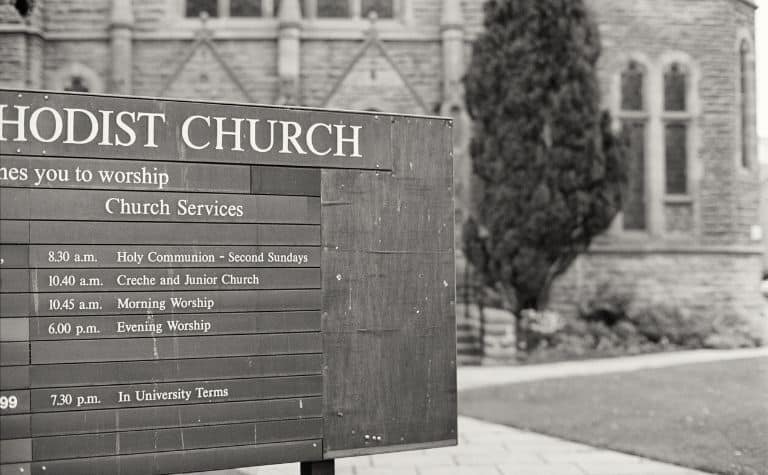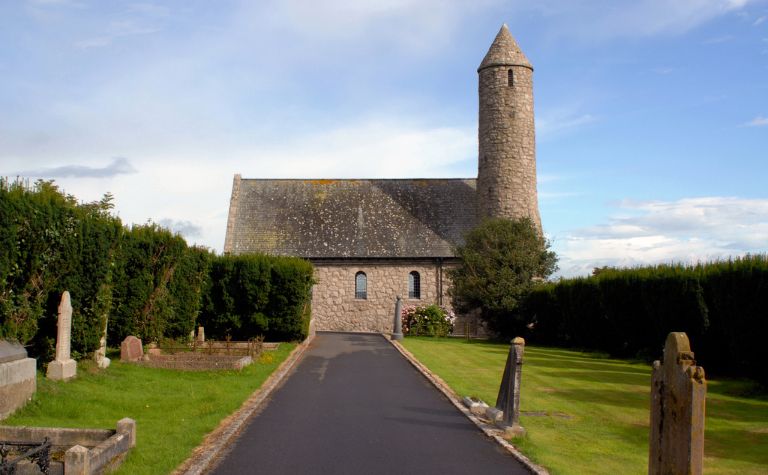Many people have heard of the Episcopalian and Methodist denominations but don’t know the differences and similarities between their respective churches. People may also be aware that both traditions have roots in England yet have played important roles in American Christian history as well.
The Episcopalian denomination is part of the worldwide Anglican Communion, also known as the Church of England. People often describe the tradition as halfway between Catholic and Protestant. The Methodist tradition, founded by John Wesley, is a branch of Protestant Christianity with historical ties to Anglicanism.
What do the names “Episcopalian” and “Methodist” mean? What is the largest denomination in each tradition? Do Episcopalians and Methodists believe in the Trinity, the inspiration of Scripture, and speaking in tongues? Keep reading to learn the answers to these questions and others.
Also, see Episcopalian vs. Protestant: What’s the Difference? to learn more.

Episcopal and Methodist Christianity: Denominational Comparison
John Wesley didn’t intend to start a new Christian denomination. Rather, he sought to reform the Church of England. Wesley tried to keep the Methodist movement within the English church, but it grew into its own branch of Protestant Christianity.
| Episcopalian | Methodism | |
|---|---|---|
| Name | From the Greek word for “overseer” and the Latin word for “bishop,” the term refers to a form of church government that locates ecclesiastical authority in the office of bishop as opposed to the papacy or congregational membership. The term also describes the largest tradition in the Anglican communion in America. | The term “Methodist” was a nickname that observers gave to the founder of Methodism, John Wesley (1703-1791), and his friends at Oxford University. The word “method” describes the strict discipline Wesley and others practiced. |
| Origin | The Anglican tradition dates to the time of King Henry VIII (1491-1547) and his protests against the Catholic church. Anglicanism arrived in America as soon as settlers arrived from England. The “Episcopalian” church dates to the time of the Revolutionary War (1775-1783). | John Wesley is the founder of Methodism, which arose out of the Church of England in the mid-18th century. |
| Branch of Christianity | Because its part of the Anglican Communion, many people consider Episcopalianism halfway between Protestantism and Catholicism. Many theologians and historians posit that a church can’t be “halfway Catholic,” so it’s best to consider the tradition Protestant with aspects of Catholicism woven into certain churches. | Methodists are Protestants and believe that salvation is by grace through faith and not according to works. Methodist theology is sometimes referred to as “Wesleyan theology” or “Wesleyan-Arminian theology.” |
| Early contributors | King Edward VI (1537-1553), Queen Elizabeth I (1533-1603), theologian Richard Hooker (1554-1600) | Other than John Wesley, Charles Wesley (1707-1788) and George Whitefield (1714-1770) played key roles in the denomination’s formation. |
Also, see What Do Episcopalians Believe? to learn more.
| Episcopalian | Methodism | |
|---|---|---|
| Organization | The word “episcopal” comes from the Greek word for “overseer” and the Latin word for “bishop.” It refers to a form of church government that locates ecclesiastical authority in the office of bishop as opposed to the papacy, like in Catholicism, or the congregation, like in some Protestant traditions. | The term “connectionalism” describes the network of relationships among Methodist churches. “Bishops” lead churches within the framework of episcopalian polity. |
| Authority | Historically, Episcopalianism, like the Anglican communion, values the Bible. The tradition affirms the Apostles Creed and the Nicene Creed. The Book of Common Prayer is also a pivotal document to the heart and identity of the tradition. | As Protestants, Methodists have historically held that the Bible alone is authoritative for establishing doctrine and ordering Christian living. Methodism historically affirms the Apostles Creed and the Nicene Creed, The Book of Common Prayer, and hymnals important to the tradition. |
| Divisions | The denomination called the “Episcopal Church” is the largest by a significant margin. Denominations and churches have split over theological, political, and social issues. Examples of contentious topics include women in ministry, allegations of devaluing Scripture, and issues related to same-sex marriage and gender identification. | There are many denominations in the Methodist tradition. The United Methodist Church is the largest and has adopted liberal perspectives on many social and theological issues in recent decades. Other small denominations maintain conservative positions. |
| Social worldview today | The “Episcopal Church,” the largest communion in America, is socially and theologically liberal. | The largest denomination in the tradition, the United Methodist Church, has experienced significant tension in recent years over social issues related to same-sex marriage and gender identification. |
The Episcopalian tradition in America has different expressions in twenty-first-century America. The denomination called the “Episcopal Church” is the largest by a significant margin.
Denominations and churches have split over theological, political, and social issues. Examples of contentious topics include women in ministry, allegations of devaluing Scripture, and issues related to same-sex marriage and gender identification.
| Episcopal Denominations | Reported Membership |
|---|---|
| Episcopal Church | 2 million |
| Anglican Church in North America | 112,000 |
| Continuing Anglican Churches | 100,000 |
| Reformed Episcopal Church | 15,000 |
What are the “high church” and “low church” Anglicanism and Episcopalianism? The high church wing emphasizes the tradition’s similarities to Catholicism and practices aspects of High Mass. The low church wing emphasizes the tradition’s similarities with Protestantism and its roots in the Reformation.
- Today, some Episcopalian congregations in America emphasize beliefs and practices that are considered Catholic.
- Other churches are aligned with conservative evangelical theology, some of which embrace charismatic expressions of worship and prayer.
- Still, other Episcopal churches have largely abandoned historical Catholicism and Protestantism and have adopted liberal and progressive social-political convictions and have less theological focus.
There isn’t a single Methodist denomination. It’s more accurate to speak of the “Methodist tradition,” which is comprised of different denominations. The largest Methodist denominations are:
| Methodist Denominations | Reported Membership |
|---|---|
| The United Methodist Church (UMC) | 7.6 million |
| African Methodist Episcopal Church (AMEC) | 2.5 million |
| African Methodist Episcopal Zion Church (ECO) | 301,000 |
| Christian Methodist Episcopal Church (CMEC) | 290,000 |
Also, see Episcopalian vs. Evangelical: What’s the Difference? to learn more.

Episcopalian vs. Methodist Beliefs
| Episcopalian | Methodism | |
|---|---|---|
| View of the Bible | Traditionally, the “low church” (see above) has a high view of Scripture in alignment with Protestantism. The “high church” values Scripture plus ecclesiastical tradition. Liberal and progressive congregations have decentralized Scripture. People can read deutero-canonical literature or the Apocrypha, but they can’t be used to establish doctrine. | The Bible is inspired, according to traditional Methodist teaching. Some conservative Methodist denominations in America accept and use the term “inerrancy,” which means that Scripture is without error. |
| View of God | Episcopalians believe in the Trinity; there is one God who exists in three persons. The Father, Son, and Holy Spirit are each fully divine. | Methodists believe in the Trinity as well. |
| View of Christ | Historically, Episcopalianism has affirmed that Jesus is the second person of the Trinity. He is God in human flesh. He is 100% God and 100% man. Jesus was born of a virgin, lived a sinless life, died as an atonement for sin, was physically resurrected on the third day, and ascended into heaven. | Methodists believe the same essential truths about the person and work of Christ as Episcopalians do. |
| View of Salvation | Episcopalianism’s roots in Anglicanism are closer to Calvinism than Arminianism. However, Arminianism grew to characterize and influence the tradition more. Today, liberal and progressive congregations are ecumenical and inclusive of other religions. | Methodists are Arminian, as opposed to Calvinists or Reformed. As Protestants, Methodists have historically held that salvation is by grace through faith in Christ alone, as opposed to good works. |
| View of the Holy Spirit | The Holy Spirit is the third person of the Trinity. He is fully divine. Episcopalians are historically cessationists, yet some small communions practice charismatic worship (e.g., International Communion of the Charismatic Episcopal Church). | Methodists believe the same essential doctrines as Episcopalians regarding the person and work of the Holy Spirit. Some Methodists practice Pentecostal expressions of worship and prayer, such as speaking in tongues. |
Also, see Christian Denominations Compared to learn more.

| Episcopalian | Methodism | |
|---|---|---|
| View of the Ordinances or Sacraments | All Episcopalian expressions recognize baptism and the Lord’s Supper. Those who have convictions that align with the high church recognize the other five that Catholicism does. The Anglican-Episcopalian tradition teaches that the sacraments are a means of grace, as in Catholicism. | Like most Protestants, Methodists recognize the two sacraments that Christ explicitly taught: baptism and communion. |
| View of the Lord’s Supper | Christ is present in the elements, but there is a mystery to it. The tradition doesn’t fully embrace Catholicism’s theology of the Eucharist but affirms that consuming the elements is more than simply a memorial practice. | Methodists believe in the real presence of Christ, making it more than a memorial like in some Protestant traditions, but they don’t believe in transubstantiation as Catholicism teaches. |
| View of the Baptism | Clergy baptize infants and adults; baptized individuals are “grafted into the church.” | Methodists baptize infants as a sign of regeneration. |
| View of the End Times | Episcopalians believe in the Second Coming of Christ. The tradition’s eschatology is Amillennial, as opposed to Premillennial or Postmilennial. | The Second Coming of Christ is a primary doctrine; the millennium is understood according to Amillennial theology. |
Also, see Episcopalian vs. Christianity: What’s the Difference? to learn more.
Related Questions
Episcopalian and Baptist are two of the largest branches of the Christian faith in America, though churches belonging to each tradition can also be found around the world. Many people know that...
Many people have heard of the Episcopalian and Methodist denominations but don't know the differences and similarities between their respective churches. People may also be aware that both traditions...
